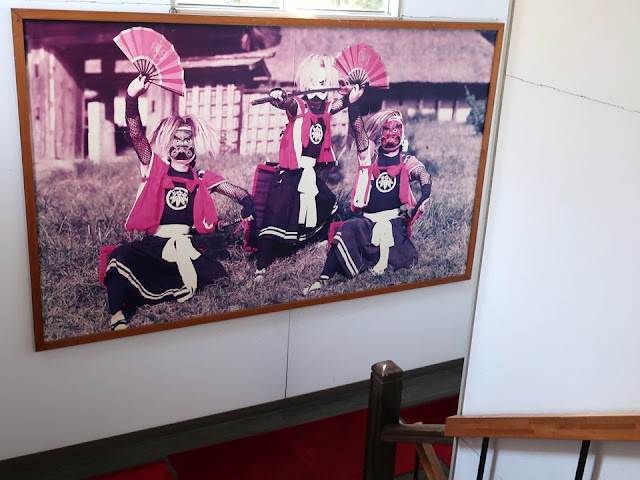Michinoku (northern Japan) Folklore Village in Kitakami city in Morioka prefecture has ten old houses which were moved from various places in the area. The museum is in the village and it has plenty of old utensils and tools which inform me how people lived and enjoyed their lives.
古民家を集めた「みちのく民俗村」の中に民俗資料館があります。民具の物量が豊富で、人々の暮らしや楽しみが伝わってきました。
The building was a girls’ high school which was built in 1927; it is designated as a national cultural asset.
資料館は、昭和2年に建造された黒沢尻実科高等女学校の校舎でした。国指定登録文化財です。
Horse and farming tools、馬と農具
The full-scale model of the horse is small. I think it is a domestic variety. In Nanbu area, people kept a horse in their house and cherished it. The horse covers its head with a cloth which is similar to a farmer; it’s adorable. The tools for farming by horses were developed.
馬の実物模型を展示しています。小柄なので国産種だったのかも知れません。南部では、馬を家の中に飼って大切にしました。馬のための農具も進化しました。畜力農業です。馬はほっかぶりをしている様で親しみが湧きます。
Human being and farming tools、人と農具
Frequently used hoes were improved well; people made hoes for farming rice fields, hoes for making rice fields walls and so on. Moreover, people made ones for soft soils and for hard soil. It is very Japanese to make various tool depending on the purpose.
Btw, a hoe was valuable; a farmer who
didn’t have it borrowed it from others or used primitive ones.
頻繁に用いられる鍬(くわ)は進化を遂げてきました。田起や畦作りなどの用途によって、また、土壌の硬軟によって、様々な形を作ったそうです。カスタマイズが得意な日本のモノ作りの特徴がでています。
鍬は貴重品で、鍬を持たない農家は、鍬を借りたり(「貸鍬」という慣行があったそうです)、足の力で耕す「踏鋤(すき)」を使ったりしたそうです。
Tools for harvesting: it says “Harvesting is a delightful time for farmers”, that’s right. It also says, “After harvesting and post harvesting work, people had a habit of making mochi rice cakes and rewarding for their pains”. Good!
収穫の農具。「収穫は、農民にとって大きなよろこびです」と書かれています。異議なし。「秋じまいの庭しごとが終わると、餅をつき、労をねぎらうのが習いでした」、いいですねえ。
Straw is important byproducts of rice farming. Various things are made from straw, such as a rain coat and shoes.
稲作の大切な副産物、藁を加工する道具や、簑などの藁製品です。
Straw shoes (sandals, snow boots and so on). Men made them in winter. We Japanese seldom utilized leather, but often used straw as materials.
様々な藁の履き物、雪国ならではのブーツ状の物もあります。藁製品を作るのは、冬場の男の仕事だったそうです。皮を使わず、藁でいろいろ作るのが稲作民族らしいです。
Women made threads, fabrics and clothes. Rustic farming work clothes are displayed (upper left).
女性の仕事は、糸を紡ぎ、生地を織り、着物を縫うことでした。素朴な農作業着が展示されています(左上)。
Tools for making thatched roof. A professional carpenter was hired, and all villagers worked together. Yoshino family in Chiba also did in the same way in the Edo period.
Reference: Yoshino’s daily life 18, May in 1851(嘉永4年5月)
屋根葺き道具。屋根葺きは、部落総出で行いますが、特殊な技術が必要で葺大工という専門職人がいました。千葉の吉野家の日記(江戸後期)にも、屋根葺きが来たことが書かれています。
The photo above is a local folk performance “Oni kenbai”.
二階への階段の踊り場には鬼剣舞(おにけんばい)の写真が展示されています。当地の特徴的な民俗芸能です。
Kitchenware、台所用品
There are many exhibits regarding the fireplace “irori”.
こちらも多量に展示されています。囲炉裏の道具がたくさんあります。
While seeing exhibits, I felt someone was using these utensils and was smiling to me. Because, it is similar to the real kitchen. Btw, something like a broad bean was used as kitchen detergent.
人の楽しみをダイレクトに展示しているわけではないのですが、展示品の向こうに何か人の笑顔を感じます。左側に吊してある空豆のような物は、洗剤として使うそうです。
Lighting and heating、照明と暖房
The nightwear was used as a comforter. It prevented cold air from coming into.
掛け布団に相当する夜着(よぎ)もあります。誰かが包まって寝たのでしょう。かいまき布団ともいいますね。一日の終わりはホッとするものです。
Puppet show、人形芝居
Dolls are rustic. Kamado god, which looks at the entrance and stop a demon, is scared. There are many Kamado gods with dreadful faces in Tohoku region.
使っていたものが蔵から出てきた、という感じで、素朴です。
右側には、竈神が展示されています。東北では、竈神が家の入口をにらみ、魔の侵入を食い止めます。凄みのあるものがたくさんあるということです。
Faith、信仰
People thanked and prayed to the necessities in their lives such as water, fire and snow.
The straw doll on the left is used during the festival which expels plague. People make the doll and put it on the tree at the village boundary. Then, they pray for a healthy life and drink together.
日常生活に欠かせない水や火、更には水をもたらす雪にも感謝して祈願しました。
左は、湯田町の疫病祭の厄払い人形です。人形を作って、村境の木に結わい、酒を酌み交わして人形に無病息災を祈願します。
Craftsmen’s tools、職人の道具
Tools for wooden crafts. I could imagine the people while looking at these tools and materials.
木工用の道具も多量に展示されています。次々と道具を拝見していると、何か使っていた人が浮かんできます。
Tools of horse grooms. I felt the craftsman came back soon. I think the display is realistic.
鍛冶屋の道具。馬繕いですね。ここも、仕事している人が出てきそうでした。見せ方がいいですね。。
Tools for forestry. There are many kinds of tools. It is very Japanese that workers require customized tools. It is strength of Japanese to make a good product, but it is an obstacle in order to standardize and reduce the cost.
山の仕事にも様々な道具があります。日本人は器用だと思いますが、カスタマイズし過ぎですかね。標準化は苦手ですね。
Iron pot and wooden tank for sake (alcohol) brewery. Famous brewer group “Nanbu toji” are in this region. They go to brewers across Japan especially in winter which is an agricultural off-season.
酒造りを担う南部杜氏(とじ)の釜と桶も展示されています。酒造りは主婦である家刀自(とじ)の役目、刀自が杜氏の語源になったといわれているそうです。パネルには「とうじ」ではなく、「とじ」とふりがなを打ってました。日本の酒造りは、男の世界だと思い込んでいました。
酒造りの主役が男性になったのは、集団で取り組むようになった近世だったそうです(酒場の誕生、玉村豊男編、1998)。技術が向上し、芳醇な酒があらわれたそうです。
The building was a girls’ high school. The photo above is uniforms of successive students. Western style ones are called “sailor-fuku” (sailor school uniform).
民俗資料館になった女学校の歴代の制服の展示です。洋服になった後は余り変わらないですかねえ。これを着て通っていた彼女たちにとっては、とっても熱い展示だと思います。
Kitakami city firefighting museum、北上市消防資料館
The museum is connected to the folklore museum. Actual fire engines and equipment are exhibited. Fans of firefighting will be fascinated.
民俗資料館と棟続きです。消防車・放水装置の実物が展示されています。消防マニアの聖地でしょうねえ。
I am interested in their lunch boxes.
私は、マニアックな所で引っかかりました。消防組へ出すお弁当箱です。
Those were also used at the firefighting events. Those exhibits are very realistic because I can easily image how someone used these.
消防の行事の時も使われました。ここの展示は、「使っていました」が伝わってきて、実感が湧きます。
Visited in November, 2020
Official website: http://michinoku-fv.net/know.php (in
Japanese), accessed in August, 2021
Previous post (Old town in the neighboring prefecture):
Masuda town in Akita and an ex hardware store “Ishihei”、増田(秋田県)と旧石平金物店
Next post (Preserved
old houses and a museum in the same site):
Michinoku Folklore Village & Kitakami City Museum、みちのく民俗村と北上市立博物館























Comments
Post a Comment